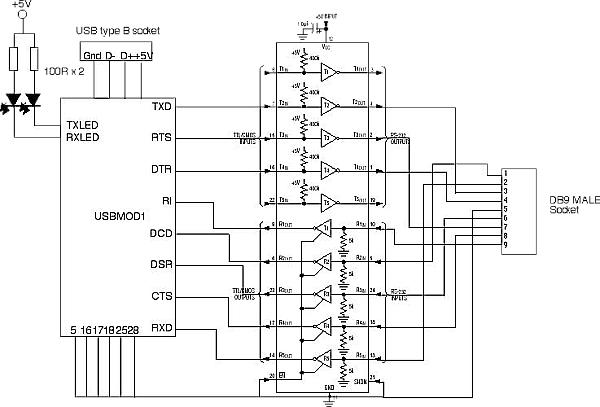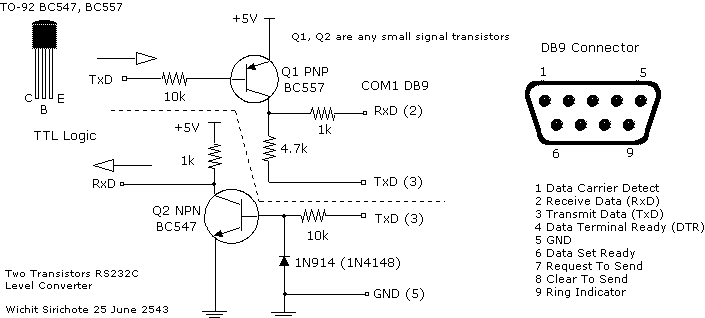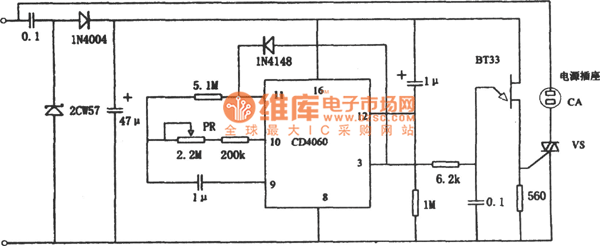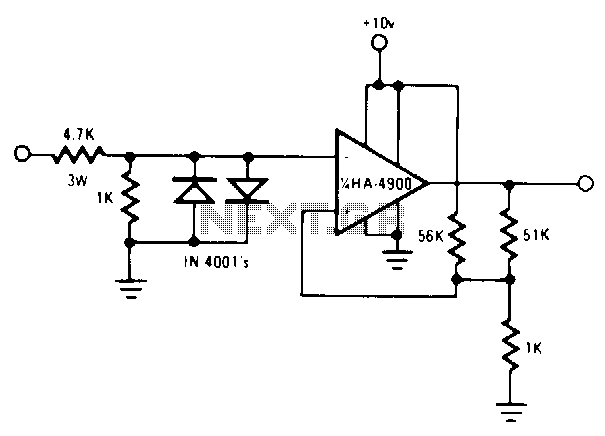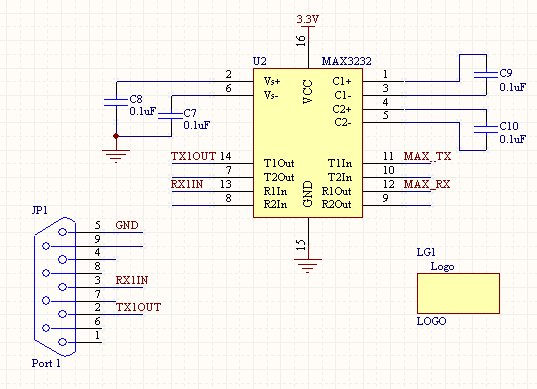
RS232 Reset for Microprocessor
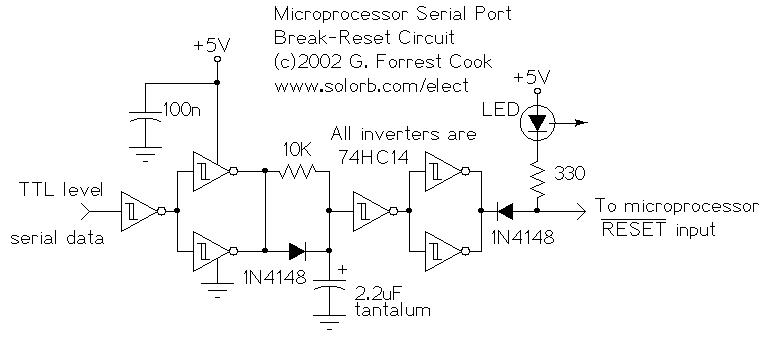
This circuit enables a remote microprocessor to reset the control of a host by sending an interrupt signal over an RS-232 or RS-422 serial line. When the remote machine is restarted using a simple program loader, it may cause the host to either stop and restart or stop and reload/restart the program on the remote machine. This method is particularly effective for developing software in EPROM-based systems. Modern EEPROM/NVRAM systems utilize JTAG interfaces to achieve similar outcomes. The remote processor executes code outside the target RAM, facilitating easy updates. Although primarily designed for code development on a target processor, this circuit can also be employed in permanent applications within the host system's target program. An example of its application includes loading code into a microprocessor-based satellite receiving system in Hawaii, communicating with a host in Colorado through an Internet-based distance learning program. A program loader for the Z80 CPU is available. The circuit has also been utilized with the Motorola 68HC11 EVB in conjunction with monitoring programs and Buffalo. For further details, refer to the Linux Cross Assemblers page. This circuit detects zero-length (break) signals in the NRZ (non-return-to-zero) serial data line. Standard characters typically spend a brief period in the zero state, which does not trigger a reset. However, break signals are an exception, as they hold the line low for an extended duration. The circuit includes a 10K resistor and a 1N4148 diode, along with a 2.2uF capacitor that is charged. Low input signals pass through the 10K resistor, gradually discharging the 2.2uF capacitor. High input signals quickly recharge the capacitor via the diode. A break signal lasts long enough to discharge the 2.2uF capacitor to the point where the next state change occurs. This circuit can be assembled using two buffers, with the 74HC14 Schmidt trigger inverter being a commonly used component. Parallel inverters are optional but will function effectively. A Z80 assembly language program is provided as a boot loader for use with the RS-232 microprocessor reset circuit. This code operates on an older SD SBC200 board, and the Z80 circuit can be adapted for other Z80 boards by modifying the initialization and serial port functions.
This circuit serves as a robust solution for remote microprocessor control and reset, leveraging serial communication protocols to facilitate efficient software development and system management. The use of RS-232 or RS-422 lines ensures reliable data transmission over varying distances, making it suitable for applications where physical proximity between devices is not feasible. The integration of a break signal detection mechanism enhances the circuit's responsiveness to control commands, allowing for timely resets and program reloads.
The design incorporates a 10K pull-down resistor that works in tandem with the 2.2uF capacitor to ensure that the circuit can effectively differentiate between standard data signals and break signals. This differentiation is crucial for maintaining system stability, as it prevents accidental resets during normal operation. The 1N4148 diode plays a vital role in managing the charging and discharging cycle of the capacitor, ensuring that the circuit remains responsive to control signals while also protecting against voltage spikes.
The choice of the 74HC14 Schmidt trigger inverter is particularly advantageous due to its high noise immunity and fast switching capabilities, which are essential for maintaining signal integrity in high-speed applications. Furthermore, the option to use parallel inverters allows for flexibility in circuit design, enabling customization based on specific application requirements.
In summary, this circuit not only provides a means for remote control and reset of microprocessor systems but also serves as a valuable tool for software development, particularly in environments utilizing older microprocessor architectures such as the Z80 and Motorola 68HC11. Its adaptability and effectiveness in various applications underscore its significance in the field of electronics engineering.This circuit allows a remote microprocessor to reset the control of a host by sending an interrupt signal on an RS-232 or RS-422 serial line. If the remote machine is restarted on a simple program loader program, it is possible that the host to stop and restart, or stop and reload / restart the program the remote machine.
This is an ideal way to d evelop software in EPROM higher based systems. Modern EEPROM / NVRAM systems use JTAG interfaces to achieve similar results. The remote processor will run your code outside RAM target, which allows code to be updated easily. The circuit is generally used to develop code on a target processor, but can also be used for permanent applications in the target program on the hard lives of a host system. This system was used once to load the code into a microprocessor-based satellite receiving system in Hawaii to a host in Colorado with an Internet-based distance learning program for serial communications.
A program loader for the Z80 CPU is available below. The circuit has also been used Motorola 68HC11 EVB with the monitoring program and Buffalo. See my Linux Cross Assemblers page for more information. This circuit detects signals from zero-length (breaks) in an NRZ (non return to zero) of the serial data line. Normal standard characters spend a short time in the zero state, and do not cause a reset. Break signals are an exception to this, hold the line low for an extended period. The parties maintain 10K/1N4148 2. 2uF capacitor charged. Low input signals go through the 10K resistor and slowly pull the load on the 2. 2uF capacitor below. The high input signals rapid recharging of the capacitor through the diode 1N4148. A break signal lasts long enough to download the 2. 2uF capacitor to the point where the next door changes state. This circuit can be constructed with only two buffers Schmidt trigger investment not, 74HC14 was chosen because it is a common part.
Investors are also optional parallel, investors will only work well. This is a Z80 assembly language program that works as a boot loader for use with microprocessor reset circuit RS-232. This code runs on an old SD SBC200 board systems and circuit Z80 can do to work with other boards Z80 changing the initialization and functions of the serial port.
🔗 External reference
This circuit serves as a robust solution for remote microprocessor control and reset, leveraging serial communication protocols to facilitate efficient software development and system management. The use of RS-232 or RS-422 lines ensures reliable data transmission over varying distances, making it suitable for applications where physical proximity between devices is not feasible. The integration of a break signal detection mechanism enhances the circuit's responsiveness to control commands, allowing for timely resets and program reloads.
The design incorporates a 10K pull-down resistor that works in tandem with the 2.2uF capacitor to ensure that the circuit can effectively differentiate between standard data signals and break signals. This differentiation is crucial for maintaining system stability, as it prevents accidental resets during normal operation. The 1N4148 diode plays a vital role in managing the charging and discharging cycle of the capacitor, ensuring that the circuit remains responsive to control signals while also protecting against voltage spikes.
The choice of the 74HC14 Schmidt trigger inverter is particularly advantageous due to its high noise immunity and fast switching capabilities, which are essential for maintaining signal integrity in high-speed applications. Furthermore, the option to use parallel inverters allows for flexibility in circuit design, enabling customization based on specific application requirements.
In summary, this circuit not only provides a means for remote control and reset of microprocessor systems but also serves as a valuable tool for software development, particularly in environments utilizing older microprocessor architectures such as the Z80 and Motorola 68HC11. Its adaptability and effectiveness in various applications underscore its significance in the field of electronics engineering.This circuit allows a remote microprocessor to reset the control of a host by sending an interrupt signal on an RS-232 or RS-422 serial line. If the remote machine is restarted on a simple program loader program, it is possible that the host to stop and restart, or stop and reload / restart the program the remote machine.
This is an ideal way to d evelop software in EPROM higher based systems. Modern EEPROM / NVRAM systems use JTAG interfaces to achieve similar results. The remote processor will run your code outside RAM target, which allows code to be updated easily. The circuit is generally used to develop code on a target processor, but can also be used for permanent applications in the target program on the hard lives of a host system. This system was used once to load the code into a microprocessor-based satellite receiving system in Hawaii to a host in Colorado with an Internet-based distance learning program for serial communications.
A program loader for the Z80 CPU is available below. The circuit has also been used Motorola 68HC11 EVB with the monitoring program and Buffalo. See my Linux Cross Assemblers page for more information. This circuit detects signals from zero-length (breaks) in an NRZ (non return to zero) of the serial data line. Normal standard characters spend a short time in the zero state, and do not cause a reset. Break signals are an exception to this, hold the line low for an extended period. The parties maintain 10K/1N4148 2. 2uF capacitor charged. Low input signals go through the 10K resistor and slowly pull the load on the 2. 2uF capacitor below. The high input signals rapid recharging of the capacitor through the diode 1N4148. A break signal lasts long enough to download the 2. 2uF capacitor to the point where the next door changes state. This circuit can be constructed with only two buffers Schmidt trigger investment not, 74HC14 was chosen because it is a common part.
Investors are also optional parallel, investors will only work well. This is a Z80 assembly language program that works as a boot loader for use with microprocessor reset circuit RS-232. This code runs on an old SD SBC200 board systems and circuit Z80 can do to work with other boards Z80 changing the initialization and functions of the serial port.
🔗 External reference
